#C-Matric
Explore tagged Tumblr posts
Text
Comprehensive DevOps Services & Solutions for Efficient Operations

Streamline your software delivery with C-Metric's DevOps services. Our comprehensive solutions include CI/CD, cloud automation, and infrastructure as code. We focus on enhancing collaboration, speed, and reliability through continuous monitoring. Trust us to optimize your development process for peak efficiency.
0 notes
Text
Never thought I'd reach the stage in life where I'm begging for numbers in math
#g's random musings#like srsly wtf is all this a b c matrices i cannot write abef as an actual term#and them multiply it with another keysmash#or solve cubic equations where the coefficients are abc bcd cda dab#full circle moment this is
3 notes
·
View notes
Text
When you want to give computer programming a shot but you may have a form of dyscalculia and your confidence plummets off the cliff like the coyote in the cartoons
#algorithms?!#matrices?!#discrete mathematics?!#stop stop I'm already dead!!#computer programming#software engineering#coding#javascript#c++ programming#c++#python coding
3 notes
·
View notes
Text




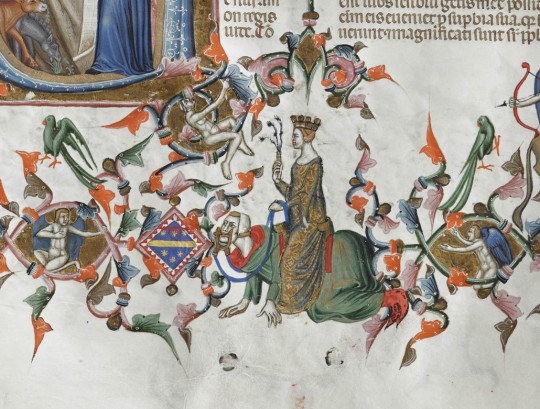



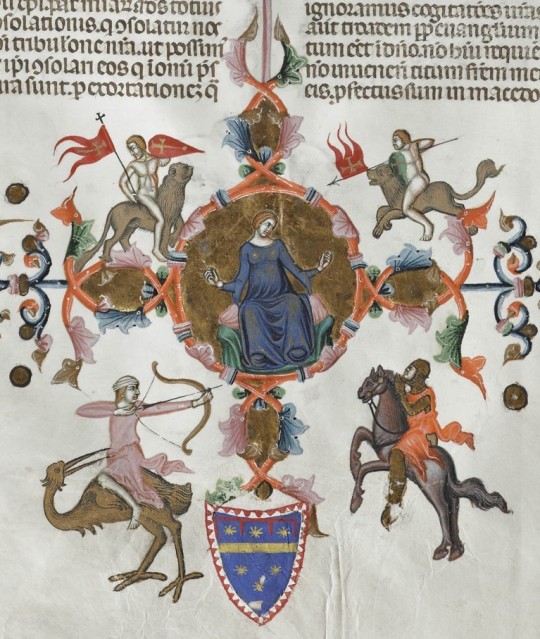
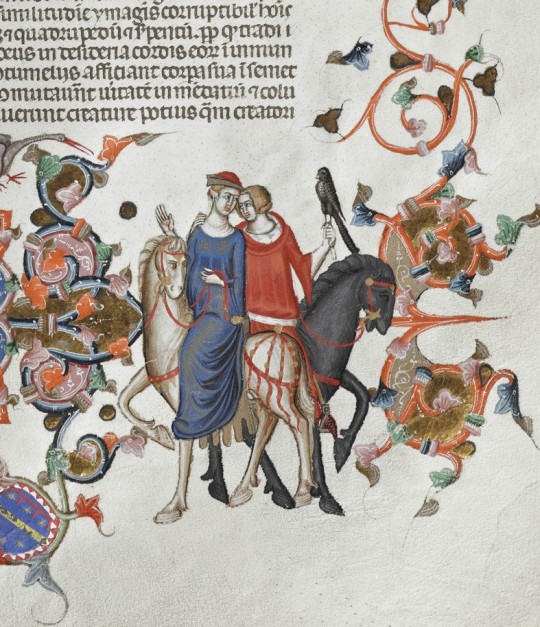
Illustrations from the Anjou Bible aka Naples Bible by Cristoforo Orimina and Iannutius de Matrice, c. 1340
#1340s#14th century#mid 14th century#Italy#illustrated manuscript#illuminated manuscript#manuscript#14th c. italy#mdp14th c.
381 notes
·
View notes
Note
What are your thoughts about Anakin/Vader and Palpatine relationship, I believe there are many unexplored nuances and dark themes there but also complicated?
They have a unique relationship (for Palpatine), in that Anakin is the only person whose love and devotion actually matters to him. He would probably couch it in terms of "absolute loyalty", but he knows what Vader feels for him is love, and that A.) it's necessary for their relationship to function B.) he has to continue consciously fostering it and C.) at some deep and subconscious level, he enjoys it.
I think there's a part of him that gets off on manipulating people in general, and the more powerful/dangerous the person, the more enjoyable it is for him (see also: him cackling as he throws the Senate at Yoda.) Since Anakin has the most raw potential of any being in SW and is "The Chosen One" (which I fully believe at some level Palpatine buys off on), he's the one that Palpatine gets the most pleasure out of controlling. While at the end of the day everyone in the Galaxy is an object for him, Anakin is the one whose loyalty he spent the most time and effort cultivating by far. Theirs is an intimate and personal relationship that he really isn't shown to have with anyone—we get glimpses of it with Padmé and Dooku, but that's as close as any of his relationships come.
There's this narcissism classification system that categorizes people in terms of providing "fuel" and as "fuel matrices", and I firmly believe that Vader is Palpatine's "Intimate Partner Primary Source." Vader provides Palpatine with a captive audience to as much of his true self as he's willing to show anyone. If there's one thing he enjoys, it's gloating. The fact that he's comfortable letting Vader into his Sith world to the degree that he (Anakin) would be able to piece together the degree to which Palpatine manipulated him during the Wars shows an astounding level of confidence in his power in the relationship.
There's a lot of "takes" on and interpretations of their relationship, but I tend to think Palpatine was more manipulative and faux-kindly than shocking Vader with Force lightning all the time. Mostly because it's more interesting, and in a way, more intensely effed up, though I also feel like it makes more sense for their established dynamic in the prequels. Fear would not be enough to motivate Vader to do what Palpatine wants him to do. Anakin is a person who tends to be more motivated by personal loyalty than to abstractions or even his own overarching goals. He needs someone to love, and the Emperor knows this. He's always understood that Obi-Wan and Padmé were his prime competition for primary loyalty.
The paradoxical aspect of their relationship is that while Palpatine thrives on Vader's devotion, because he himself is incapable of actual love, there's a part of him that is incapable of respecting Vader as an apprentice because of it. I suspect that he finds Vader's paternal reasons for finally getting the guts to go up against him distasteful.
If Luke had killed Vader and turned, Palpatine probably would have been low-key disappointed with what he'd gotten and wished he'd kept the OG model, as defective as it was. I tend to think he would have enjoyed turning Leia more, as she's a weird combo of both of her parents, his favorite playthings (Padmé and Palpatine's weird relationship is underrated.)
#darth vader#darth sidious#sheev palpatine#anakin skywalker#star wars#star wars meta#luke skywalker#leia organa
30 notes
·
View notes
Text
The Fantasy Language Translation Matrix
Whether you intend to write your own full-blown lexicon with different verb tenses and formal vs informal language, need unique words for spellwork, or just need new names for all your foreign places, behold… the Physalian patented Fantasy Language Translation Matrix.
(I kid. I have no idea if I’m the first to come up with this)
**Disclaimer!** After rolling out your fresh new vocab off the word assembly line, make sure you google it and that it doesn’t already exist and mean something you don’t intend.
Step 1: Pick your Derivative
You can make it sound completely foreign and like total gibberish, but I find it easier for you and other people to read if they have some real-world reference to compare it to, and so they have a clue for which pronunciation rules to rely on. For example: I did not know who René Descartes was my freshman year of high school. His last name was in my algebra book, and I, thinking he was Greek like so many other ancient mathematicians, pronounced his name as if he were Greek “Des-kart-ees.” I got made fun of.
Spare your readers the humiliation.
So say I want a vaguely… Russian/Latin/Italian influence. As opposed to French. Cool. That’s my starting point.
Step 2: Reorder the most common letters from English to your new language
In English, the average use of the standard alphabet by letter in order is this:
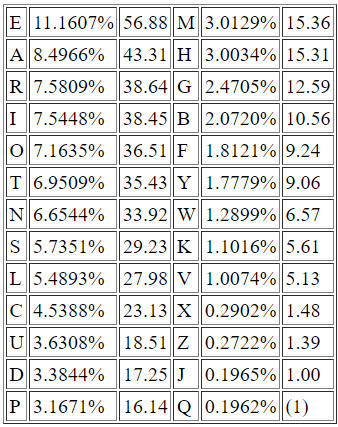
Ignore your vowels for a second. I don’t use charts like this on the regular, I use the Wheel of Fortune method and focus on RSTLNE, then go from there. I also want to make sure this isn’t a complete 1:1 ratio so it’s not super obvious I’m just juggling letters around, so I’ll knock out some “duplicate” letters and swap out singular letters for specific sounds.
The goal of this isn’t to stare at two existing language matrices and perfectly match them up, it’s to take the most common sounds and letters in English and make them new, common sounds in your new language, to sound more uniform and like you have a real etymology.
And I end up with this:

This might look a little confusing on how I got from A to Z so the basics:
All my vowels remain in the same place, they just get juggled around so I don’t end up with 8 consonants next to each other and word garbage
My “duplicate” letters are combined so I have more room for the new sounds, like c/k, f/ph/gh, h/wh, s/z. The new sounds then get the spare letters I had left over
Common english suffixes get reduced down so the pattern isn’t as obvious
If you want to include accent marks, this is your chance
I wanted to really emphasize the long “e” and long “i” sounds, so those got extra attention
Step 3: Translating
Oftentimes this is not perfect, or you end up with a word that just doesn’t fit the rest of your new vocabulary, because English is the bastard lovechild of German, Latin, Danish, and French.
I start with English, usually, but if the English word is too short or too long, I translate it first into another language, like Spanish, and go from there. Like “bus” vs “autobus”.
Using your matrix, go one by one. Let’s use a word like “letter”.
English: L-E-T-T-E-R
New: T-A-C-C-A-Z
Step 4: Polishing
So now I have my new word: “Taccaz”
Which is serviceable. I can throw an accent on either A or fiddle with the Z. I can start with “carta” instead and end up with “kizci”. The matrix is just a starting point. It’s designed to streamline the process when I’m otherwise feeling uncreative and in a rush, and it moves very quickly when I need to come up with full phrases and sentences that someone would actually say.
Step 5: Full sentences
This is only if you’re really digging deep and not coming up with the occasional fantasy curse word or new name for your fantasy land/realm/noun etc.
For this you’re going to need lots of tables. I based mine off romance languages because I know Spanish and romance languages make sense. This is where you decide how many pronouns, if any, you’re going to use, how the infinitive changes based on past, present, or future tense, how many nouns the word references, etc.
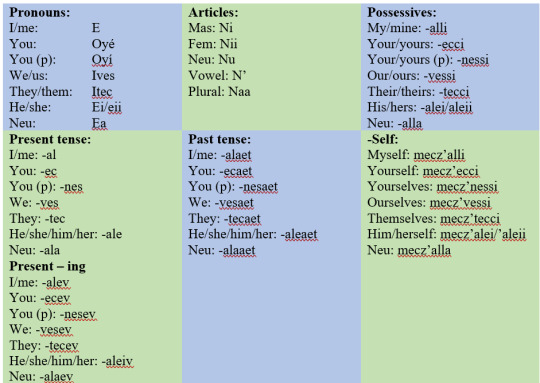
This is… a lot. Way more than you’d ever need for your manuscript. Ever. But I did it just for my own sake. Does it get long? Yes. Does it get tedious? Yes. The point here is to have little pre-manufactured word bytes you can plug and play with, with as little mental effort as possible so you can save it for the rest of your work.
I also came up with very common words already conjugated, like “to be” so I can just glance and type without having to remember to take “is” and go through the process over and over again.
Which means that I can take an entire sentence and translate it to my new language in about two minutes.
English: The payoff is worth it, this is so satisfying. New, roughly: Nu kioyb ela fyzip ne, iski ela valo nicenbalaev.
Of course, you can keep tinkering until you get something that’s easier on the eyes (I’ve been working with this language for years so I can read it pretty well), but not all languages are smooth and pretty and simple.
To be frank: Most readers will just gloss over this stuff anyway, but it shows that you put in the effort and it enhances the lore and the immersion when you do this. At least in the written medium. You can’t ignore it if this is meant to be in a screenplay.
Is this what a language professor would do or recommend? Probably not, I have no idea. Does it work? Yes. I have a fully functioning grammatical system where any input can give me a legible output.
To make this yourself, just change the order of the letters around, adjust your shortcuts, and come up with your own common sounds for those last two rows. The conjugation matrix is where you can really make it distinct, assuming you are basing yours off a romance language, which you don't have to.
—
And there you have it!
Don’t forget to vote in the dialogue poll before it closes!
#writing resources#writing advice#writing tips#writing tools#writing a book#writing#writeblr#fantasy#sci fi#fictional language#language#world building
51 notes
·
View notes
Text
We watched the DVD of the matrix illustrations and OMGGGGGG CHARA DESIGN STUFF!!!????
TRINITY ILLUSTRATIONS ?????
There's all the concept art for ships, machines, Location (Zion and matrice) AND
C H A R A D E S I G N
I haven't managed to find them on the Internet yet, but I hope to be able to share them with you one day (At the moment I don't have a DVD player on my computer...).
There's enough content to make another artbook, I'm sad they didn't.
I can show you this Trinity concept art from the booklet.

Here's a link to what's on the DVD :
9 notes
·
View notes
Text
Las matrices prehistóricas de las civilizaciones antiguas en la obra póstuma de Spengler: Atlantis, Kusch y Turan

Por Robert Steuckers
Traducción de Juan Gabriel Caro Rivera
En general, las morfologías de las culturas y civilizaciones propuestas por Spengler en su obra más famosa, La decadencia de Occidente, son las únicas que se conocen. Sin embargo, sus posiciones cambiaron tras la publicación de esta obra. El erudito italiano-alemán Domenico Conte lo señala en su reciente libro sobre Spengler. De hecho, un estudio más profundo de los textos póstumos editados por Anton Mirko Koktanek, en particular Frühzeit der Weltgeschichte, que reúne los fragmentos de una obra proyectada pero nunca terminada, La epopeya del hombre, lo demuestra.
En la fase de su pensamiento que siguió inmediatamente a la publicación de La decadencia de Occidente Spengler distinguió cuatro etapas en la historia de la humanidad, que designó simplemente con las cuatro primeras letras del alfabeto: a, b, c y d. La etapa «a» habría durado unos cien mil años, abarcando el Paleolítico Inferior y acompañando las primeras fases de la hominización. Fue durante esta etapa cuando surgió la importancia de la «mano» para el hombre. Para Spengler se trata de la Edad de Granito. El estadio «b» habría durado unos diez mil años, durante el Paleolítico Inferior, entre el 20.000 y el 7.000/6.000 a.C. Fue durante esta época cuando nació la noción de vida interior y «apareció el alma verdadera, desconocida para los hombres de la etapa “a” como es desconocida para el niño recién nacido». Es a partir de este momento de su historia cuando el hombre «es capaz de producir huellas/recuerdos» y de comprender el fenómeno de la muerte. Para Spengler, ésta es la Edad de Cristal. Las etapas «a» y «b» son inorgánicas.
La etapa «c» dura 3.500 años: comienza con el Neolítico, del sexto milenio al tercero. Fue la etapa en la que el pensamiento comenzó a articularse en el lenguaje y se hicieron posibles los logros técnicos más complejos. Nacieron las «culturas» con estructuras «ameboides». La etapa «d» es la «historia universal» en el sentido convencional del término. Es la etapa de las «grandes civilizaciones», cada una de las cuales dura unos 1000 años. Estas civilizaciones tienen estructuras «vegetales». Las etapas c y d son orgánicas.
Spengler prefería esta clasificación psicológico-morfológica a las clasificaciones impuestas por los directores de museos, que subdividían las épocas prehistórica e histórica en función de los materiales utilizados para fabricar herramientas (piedra, bronce, hierro). Spengler también rechazó, en la estela de esta clasificación psicológico-morfológica las visiones demasiado evolucionistas de la historia humana: éstas, demasiado dependientes de los débiles ideales del siglo XVIII, conducían a la idea de «una transformación lenta y flemática» de lo dado natural, quizá obvia para el inglés (del siglo XVIII), pero incompatible con la naturaleza. Para Spengler la evolución es una serie de catástrofes, irrupciones repentinas y mutaciones inesperadas. «La historia del mundo procede de catástrofe en catástrofe, sin preocuparse de saber si somos capaces de comprenderlas. Hoy, con H. de Vries, las llamamos “mutaciones”. Se trata de una transformación interna que afecta inesperadamente a todos los especímenes de una especie, sin “causas”, por supuesto, como ocurre con todas las cosas de la realidad. Tal es el misterioso ritmo de la realidad» (El hombre y la tecnología). Así pues, no hay evolución lenta, sino transformaciones repentinas, «epocales». Natura facit saltus.
Tres culturas amebas
En el estadio «c», en el que surgen realmente las matrices de la civilización humana, Spengler distingue tres «culturas-ameba»: Atlantis, Kusch y Turan. Esta terminología sólo aparece en sus escritos y cartas póstumas. Las matrices civilizatorias son «amebas», no «plantas», porque las amebas son móviles, no están ancladas en una tierra concreta. La ameba es un organismo que emite continuamente sus pseudópodos hacia su periferia, cambiando constantemente de forma. A continuación, la cultura ameba se subdivide precisamente del mismo modo que las amebas produciendo nuevas individualidades que se alejan de la ameba madre. Esta analogía implica que no podemos delimitar con precisión el territorio de una civilización en estadio «c», porque sus emanaciones ameboides pueden estar muy dispersas en el espacio, alejadas de la ameba madre.
«Atlantis» está al “Oeste” y se extiende desde Irlanda hasta Egipto; “Kusch” es el “Sureste”, una región entre la India y el Mar Rojo. «Turan» es el “Norte” y se extiende desde Europa Central hasta China. Spengler, explica Conte, eligió esta terminología que recuerda los «antiguos nombres mitológicos» para no confundirlos con espacios históricos posteriores, de tipo «vegetal», bien situados y circunscritos en la geografía, mientras que ellos mismos están dispersos y no pueden localizarse con precisión.
Spengler no cree en el mito platónico de la Atlántida en un continente hundido, pero señala que en Occidente, desde Irlanda hasta Egipto, se pueden divisar una serie de sedimentos civilizatorios. «Kusch» es un nombre que aparece en el Antiguo Testamento para designar el territorio de la antigua Nubia, región habitada por los kuschitas. Pero Spengler sitúa la cultura ameba «Kusch» más al Este, en una región entre Turquestán, Persia y la India, sin duda inspirándose en el antropólogo Frobenius. En cuanto a «Turán» se refería al «Norte», el altiplano turanio, que él creía era la cuna de las lenguas indoeuropea y uralo-altaicas. De aquí partieron las migraciones de los pueblos «nórdicos» (no hay connotación racial en las palabras de Spengler) que recorrieron Europa, India y China.
Atlántida: cálida y móvil; Kusch: tropical y satisfecha
Atlantis, Kusch y Turan son culturas con principios morfológicos que emergen principalmente en las esferas de la religión y las artes. La religiosidad de Atlantis es «cálida y móvil», centrada en el culto a los muertos y la preeminencia de la esfera ultratelúrica. Las formas de enterramiento, señala Conte, atestiguan la intensa relación con el mundo de los muertos: las tumbas son siempre en altorrelieve o monumentales; los difuntos son embalsamados y momificados; se les deja o se les lleva comida. Esta relación obsesiva con la cadena de antepasados llevó a Spengler a teorizar la presencia de un principio «genealógico». «Las expresiones artísticas de la Atlántida», añade Conte, «se centran en construcciones de piedra, gigantescas si cabe, hechas para la eternidad, signos de un sentido de la vida que no se vuelca hacia una superación heroica de los límites, sino hacia una especie de “complacencia inerte”».
Kusch desarrolla una religión «tropical» y «satisfecha». El problema de la vida ultratelúrica se aborda con mucha menos angustia que en la Atlántida, porque en la cultura ameba de Kusch domina una matemática del cosmos (de la que Babilonia será la expresión más grandiosa) donde las cosas están «rígidamente determinadas» de antemano. La vida después de la muerte es una cuestión indiferente. Si la Atlántida es una «cultura de tumbas», en Kusch las tumbas carecen de sentido. Aquí la gente vive y procrea, pero los muertos son olvidados. El símbolo central de Kusch es el templo, desde el que los sacerdotes escrutan las matemáticas celestiales. Mientras que en la Atlántida domina el principio genealógico y los dioses y diosas de la Atlántida son padre, madre, hijo e hija, en Kusch las divinidades son las estrellas. Domina un principio cosmológico.
Turán: la civilización de los héroes
Turán es la civilización de los héroes, impulsada por una religiosidad «fría» centrada en el sentido misterioso de la existencia. La naturaleza está llena de poderes impersonales. Para la cultura de la Ameba Turan, la vida es un campo de batalla: «para el hombre de este Norte (Aquiles, Sigfrido)», escribe Spengler, «lo único que cuenta es la vida antes de la muerte, la lucha contra el destino». La relación entre el hombre y el dios ya no es de dependencia: «cesa la postración, la cabeza permanece erguida y alta; hay un “yo” (el hombre) y vosotros (los dioses)». Los hijos están llamados a mantener vivo el recuerdo de sus padres, pero no dejan comida para sus cadáveres. En esta cultura no hay embalsamamiento ni momificación, sólo incineración: los cuerpos desaparecen, ocultos en tumbas subterráneas sin rasgos o esparcidos a los cuatro vientos. Lo único que permanece es la sangre del difunto, que corre por las venas de sus descendientes. Turan es, por lo tanto, una cultura sin arquitectura, donde los templos y las tumbas carecen de importancia y lo único que importa es el sentido terrenal de la existencia. El hombre vive solo, enfrentado a sí mismo, en su casa de madera o barro o en su tienda nómada.
El carro de combate
Spengler simpatiza mucho con la cultura de la ameba turaniana, cuyos portadores aman la vida aventurera, están impulsados por una voluntad implacable, son violentos y carecen de vano sentimentalismo. Son «hombres de acción». Los distintos pueblos turanianos no están unidos por lazos de sangre ni por una lengua común. A Spengler no le interesan las investigaciones arqueológicas y lingüísticas destinadas a encontrar la patria original de los indoeuropeos o a reconstruir la lengua de origen de todos los modismos indoeuropeos actuales: el vínculo que une a los pueblos turanianos es técnico, el uso del carro de combate. En una conferencia pronunciada en Múnich el 6 de febrero de 1934, titulada Der Streitwagen und seine Bedeutung für den Gang der Weltgeschichte (= El carro de combate y su importancia para el curso de la historia del mundo) Spengler explica que esta arma es la clave para comprender la historia del segundo milenio antes de Cristo. Fue, dice, la primera arma compleja: requería un carro (con dos ruedas, no un carro de cuatro ruedas menos móvil), un animal domesticado enjaezado a él y una preparación meticulosa por parte del guerrero, que ahora debía golpear a sus enemigos desde arriba. Con el carro nació un nuevo tipo de hombre. El carro de guerra fue un invento revolucionario en términos militares, pero también fue el principio configurador de una nueva humanidad. Los guerreros se hicieron profesionales, tan complejas eran las técnicas que debían manejar, y se agruparon en una casta amante del riesgo y la aventura; hicieron de la guerra el sentido de sus vidas.
La llegada de estas castas de impetuosos «carros» alteró el orden de tiempos muy antiguos: en Grecia, derrocaron a los aqueos y se asentaron en Micenas; en Egipto, arrasaron los hicsos. Más al este, los casitas se lanzaron sobre Babilonia. En la India, los arios inundaron el subcontinente, «destruyeron las ciudades» y se asentaron sobre los escombros de las civilizaciones conocidas como Mohenjo Daro y Harappa. En China, los chou llegaron del norte, montados en sus carros, como sus homólogos griegos e hicsos. A partir de 1200, los principios guerreros reinaron en China, India y el antiguo mundo mediterráneo. Los hicsos y los casitas destruyeron las dos civilizaciones más antiguas del sur. Surgieron entonces tres nuevas civilizaciones, dirigidas por «carros dominadores»: la civilización grecorromana, la civilización aria de la India y la civilización china nacida de los Chou. Estas nuevas civilizaciones, originarias del norte, de Turán, eran «más viriles y enérgicas que las nacidas a orillas del Nilo y del Éufrates». Pero los carismáticos guerreros sucumbieron a las seducciones del Sur que los ablandó, lamentó Spengler.
Un sustrato heroico común
Spengler desarrolló esta teoría de acuerdo con el sinólogo Gustav Haloun: las invasiones de Grecia, los hicsos, India y China fueron casi simultáneas. Spengler y Haloun creen, por lo tanto, que las civilizaciones mediterránea, india y china comparten un sustrato guerrero y de carros común. Este sustrato es «heroico», como demuestran las armas de Turan. Son diferentes de las de la Atlántida: además del carro, son la espada o el hacha, lo que implica duelos entre combatientes, mientras que en la Atlántida las armas son el arco y la flecha, que Spengler considera «viles» porque permiten evitar el enfrentamiento físico directo con el adversario, «mirarle directamente a los ojos». En la mitología griega, opina Spengler, los arcos y las flechas son indicios de un pasado e influencias prehelénicas: Apolo, el arquero, procede de Asia Menor, Artemisa es libia, al igual que Heracles, etcétera. La jabalina también es «atlante», mientras que la lanza de choque es «turaniana». Para comprender estas épocas lejanas, el estudio de las armas es más instructivo que el de los utensilios de cocina o las joyas», concluye Spengler.
El alma turaniana también deriva de un clima particular y de un paisaje hostil: el hombre debe luchar constantemente contra los elementos, volviéndose por ello más duro, frío e invernal. El hombre no es sólo el producto de una «cadena genealógica», sino también de un «paisaje». Un clima riguroso desarrolla la «fortaleza». El trópico suaviza los caracteres, los acerca a una naturaleza percibida como más maternal y favorece los valores femeninos.
Los últimos escritos y la correspondencia de Spengler indican, por lo tanto, que sus posiciones cambiaron tras la publicación de La decadencia de Occidente, en la que sobrevaloraba la civilización fáustica, en detrimento sobre todo de la civilización antigua. Su atención al «carro de combate» dio una nueva dimensión a su visión de la historia: el hombre griego y el hombre romano, el hombre indio-ario y el hombre chino, todos eran favorables a sus ojos. En La decadencia de Occidente la momificación de los faraones era vista como la expresión egipcia de un deseo de duración, que él contraponía al olvido que implicaba la cremación india. Más tarde, a sus ojos, la momificación «atlante» entraba en la categoría de una obsesión por el más allá, señal de una incapacidad para hacer frente a la vida terrenal. La cremación «turaniana», en cambio, indicaba un deseo de concentrar sus esfuerzos en la vida real.
¿Un cambio de perspectiva dictado por las circunstancias?
La concepción policéntrica, relativista, no eurocéntrica y no evolucionista de la historia de Spengler en La decadencia de Occidente ha fascinado a estudiosos y antropólogos ajenos a los círculos alemanes de derechas, como Alfred L. Kroeber y Ruth F. Benedict. La insistencia de Spengler en el importante papel histórico de las castas guerreras confiere a su obra tardía una dimensión más bélica, más violenta y más móvil que en su primera obra. ¿Debemos atribuir este cambio de perspectiva a la situación de una Alemania derrotada, que buscaba aliarse con la joven URSS (¿en una perspectiva euroasiático-turaniana?), con la India sublevada contra Gran Bretaña (que antes había incluido en la «civilización fáustica», a la que más tarde daría mucha menos importancia), con la China de los «grandes señores de la guerra», a veces armados y supervisados por oficiales alemanes? ¿Intentaba Spengler, con su conferencia, dar una mitología común a los oficiales o revolucionarios alemanes, rusos, chinos, mongoles e indios para forjar una futura hermandad de armas, del mismo modo que los «eurasianistas» rusos intentaban dar a la nueva Rusia soviética una mitología similar, que implicaba la reconciliación de turco-turanios y eslavos? ¿Es el énfasis radical en el combate cuerpo a cuerpo «turaniano» un eco del culto al «asalto» que se encuentra en el «nacionalismo militar», en particular los hermanos Jünger y Schauwecker?
Por último, ��por qué no escribió nada sobre los escitas, un pueblo de intrépidos guerreros, maestros de las técnicas ecuestres, que fascinaban a los rusos y sin duda, entre ellos, a los teóricos del eurasianismo? Última pregunta: ¿La falta de énfasis en los factores raciales en este Spengler tardío se debe a un sentimiento de resentimiento hacia los primos ingleses que habían traicionado la solidaridad germánica y a una nueva mitología en la que los pueblos ecuestres del continente, todos los grupos étnicos combinados (mongoles, turco-turanios, descendientes de los escitas, cosacos y uhlans germánicos), debían unir sus fuerzas contra las civilizaciones corruptas del Oeste y del Sur y contra las talasocracias anglosajonas? ¿No son los evidentes paralelismos entre el énfasis en el «carro de combate» y ciertas tesis de El hombre y la técnica una concesión a la ideología futurista imperante, en la medida en que ofrece una explicación técnica y no religiosa de la cultura ameba turaniana? Todas estas son cuestiones que la historia de las ideas deberá aclarar en profundidad...
Domenico CONTE, Catene di civiltà. Studi su Spengler, Edizioni Scientifiche Italiane, Napoli, 1994, 394 p., Lire 58.000, ISBN 88-7104-242-924-1.
Fuente: http://euro-synergies.hautetfort.com/archive/2008/10/20/spengler-atlantis-kasch-et-turan.html
3 notes
·
View notes
Text
Oooh right ok. So in the Hilbert space formalization of QM quantum states are represented by one-dimensional subspaces. And that's because each state corresponds to a family of wave functions parametrized by a complex variable, and in order to make a prediction you pick the variable (normalization) that makes the square integral equal to one. Ok ok.
So, right. I was having a little trouble understanding the Hilbert space formalization but it's the Hilbert space of square-integrable functions (from... R^4 -> C?), right? And each one is a wave function. And a quantum state is a one-dimensional subspace, i.e. a parametrized family of wave functions. Am I getting this right?
So what's the deal about observables being Hermitian matrices? I didn't get that.
Tumblr is my physics tutor. Thank you to my physics mutuals.
55 notes
·
View notes
Text
It's weird how so many game creation videos on YouTube keep coming back to learnopengl.com.
I start my own AC clone engine, in raw C++? I got started from there.
MVG starts his own boomer shooter engine, in raw C++? He learned it from there.
Code Jar makes a thing about minimap generation? He links there to help explain MVP matrices. That wasn't even in a custom-made engine, that was Godot!
Kinda makes me wonder how Joey de Vries must feel.
...
Nominated as TIME magazine's person of the year 2006.
Yeah, I can believe it.
Actually all that might be why every single tutorial is so goddamn insistent on using assimp. Sheesh.
6 notes
·
View notes
Text
Countdown to JEE (Main): Week 3/33



(I need to take new pictures LMAOOOOOOOOO)
This week was a bit less productive than usual, JEE-wise! But that's because my school unit tests have started and I needed to revise English since I had barely touched any of the lessons in the syllabus.
I think I have done more-or-less-okay in terms of question solving though... let's see —
Test results:
none this week!
Topics covered:
Physics: Electrostatics, Current Electricity, Electromagnetic Induction and Alternating Current, Gravitation, Geometrical Optics, Electromagnetic Waves, Wave Optics (7/3)
Chemistry: Solid State, Coordination Chemistry, Hydrocarbons, Alcohols and Ethers, Ionic Equilibrium, Halogen Derivatives (6/3)
Mathematics: Limits, Indefinite Integrals, Definite Integrals, Matrices (4/3)
Questions solved:
Physics: - Allen Electrostatics module, O2, JEE (Main) and JEE (Advanced) archives — 57 questions, 52 correct - Allen Geometrical Optics module, O1 — 100 questions, 95 correct - Allen Electromagnetic Induction and Alternating Current module, O1 — 33 questions, 29 correct - Allen Gravitation module, JEE (Main) archives — 43 questions, 41 correct - Allen Current Electricity module, O1 — 51 questions, 50 correct - H. C. Verma Electromagnetic Induction — 20 questions, 19 correct - H. C. Verma Light Waves — 20 questions, 19 correct - Allen Electromagnetic Waves and Wave Optics module, O1 and O2 — 47 questions, 35 correct - FIITJEE JEE (Main) archives, Optics — 21 questions, 17 correct Total: 392/60 questions, 307 correct (uh-oh, gotta work on that accuracy)
Chemistry: - Allen Solid State module, O1, O2, JEE (Main) and JEE (Advanced) archives — 131 questions, 115 correct - Allen Coordination Chemistry module, O1 — 40 questions, 34 correct - Allen Hydrocarbons module, O1, O2 and S1 — 57 questions, 55 correct - Himanshu Pandey, Alcohols and Ethers — 40 questions, 36 correct - Allen Ionic Equilibrium module, O1 — 20 questions, 18 correct - Kota Question Bank Halogen Derivatives — 40 questions, 36 correct Total: 328/60 questions, 300 correct
Mathematics: - Allen RACE 5, 6, 7 — 30 questions, 27 correct - Allen Limits module, O1 and O2 — 50 questions, 45 correct - Arihant Integral Calculus Indefinite Integrals, Exercise 1 and 2 — 55 questions, 45 correct - Sameer Bansal* Indefinite Integrals, Exercise 1 — 31 questions, 27 correct Total: 166/60 questions, 144 correct *this book was sponsored by @warning-coffee-is-explosive! thanks king <3
GRAND TOTAL: 886/400 questions, 751 correct
Oh. It turns out I just feel like I've been unproductive.
Upcoming tests:
23/06/2024 (Sunday) — Allen monthly test. Topics: Kinetic Theory of Gases; Physical Thermodynamics; Electrostatics; Potential and Capacitance; Current Electricity; Electromagnetic Induction; Alternating Current; Electromagnetic Waves; Waves on a String; Sound Waves; Ray Optics; Wave Optics; Circle; Functions; Differentiation; Applications of Derivatives; Indefinite Integrals; Definite Integrals; Area Under a Curve; Differential Equations; Matrices; Silicates; Molecules That Do Not Exist; Coordination Chemistry; Metallurgy; Electronic Displacement Effects; Halogen Derivatives; Atomic Structure; Chemical Equilibrium; Solid State; Solutions; Chemical Kinetics; Chemical Thermodynamics. I'm feeling a little better about this one now...
See you again next week!
#studyblr#desi studyblr#study blog#jee 2025#joint entrance examination#jee mains#jee advanced#weekly studyposting#porashona
12 notes
·
View notes
Note
a week ago i was making a programming language for fun and i ended up using polish notation (= + 2 2 4) because it means i didn't have to implement operator precedence
Oh, I know about this!
I used to tell my friends to kill their matrices polish style to get the determinant, because I assumed you'd write it like × - × a d b c in polish notation. I was wrong, it's actually - × a d × b c. Was a very sad day for me
Anyways, yeah, sorry for the story, very cool you get to avoid pemdas by making the order matter, but won't it get confusing to have to do all the math backwards? (Since it relies heavily on doing the furthest right expressions first)
6 notes
·
View notes
Text
Oldschool determinants & floating points
Forget those easypeasy 2x2, 3x3, and 4x4 (if you're feeling spicy) formulas for matrix determinants that you forced yourself to memorize in linear algebra. Real ones know that you can get the determinant of any matrix through LU decomposition.
Fun fact though, because Python floating point numbers aren't really the same as floating point numbers in C (python does everything with infinite precision), I was getting different answers for determinants I computed with my LU algorithm versus what NumPy was getting with the algorithm it uses from LAPACK.
For instant with a 99x99 random matrix, the absolute difference in our determinants was over 1 trillion.
BUT
Each determinant was on the order of 10^25 (because the matrices were filled with values from a uniform random distribution and to oversimplify these don't really play nice with det algorithms).
This was my value: -1.3562741025533489e+25
This was NumPy's value: -1.3562741025534902e+25
I bolded the digits where they differed in value. The actual percentage difference between them is basically 0, ~10^-10
I'm sure in some applications this would matter, but for me it doesn't really.
3 notes
·
View notes
Text
Day 1: Maintaining the Feeling of Being a Successful Business Owner
I've decided to start blogging again and I thought it would be great to start it today on the 11/11 portal. Today is a very powerful day for manifesting and I wanted to just have fun starting another daily challenge of keeping myself disciplined.
I did a 30 day BBL challenge two years ago to build my dream body (view the #me or #fitness hashtags to see what I'm talking about if you haven't already. I love what I've built physically but also mentally and emotionally. I'm more confident in myself, love myself so much more, and I hold myself to a higher standard than I have before starting that challenge.
So now I want to start a new 30 day challenge of blogging how I'm building the discipline to be successful IT Security business owner. I have been working on this for years but always fell back into doubt and fear. I think now that I'm single and I don't have anyone around me distracting me or trying to destiny swap with me I have all of my energy and power back to go full throttle. I also want to see where my confidence is by December 11.
I built an unshakable discipline for going to the gym now I can't miss a day or I feel like shit. Now I'm even walking more during the day to close all of my fitness rings on my Apple Watch. I want to get to the point in my business where I can't go a day without making an informational post for digital security across social media, expanding my knowledge in the field, and providing my clients with the best security solutions possible.
What I Worked on Today: - Building out pricing matrices for all of my services to ensure I'm making at least $10K/month - Some cloud storage filing for my first client since starting the IT Security Consulting side of my business (I've done career consulting before but slowly phased out of that because it wasn't fulfilling for me) - Joined some Facebook infosec groups as well as did some branding on TikTok for my business
What I Learned Today: - Taking aligned action is everything. Doesn't matter if it's perfect (Which has been a setback for me in the past. Trying to make sure everything is perfect instead of just creating/doing) - Keeping an abundant and positive mindset will take you far. Ever since I've decided to work on myself and become a more improved version of Empress/Tailor I have decided to let go of so many limiting beliefs. Not just in business but in money, love, and intellect. - Neville Goddard and taking frequent breaks keeps me motivated. I realized that when I'm sitting down for too long I tend to get restless and can't focus as well. Taking frequent walks and having Neville in my ear telling me to keep my thoughts aligned is why we're even here blogging because I've wanted to get back to this for a while tbh
Motivation: - Today being 11/11 and just feeling like a brand new woman. I almost slept in this morning but I hacked my brain to shut tf up and forced myself to get up and go to the gym. Multimillionaire me gets her ass up and goes to that gym at 5AM everyday unless something comes up and I can't make it. If I can't make it I'm getting atleast 10K steps in - Knowing that my reality right now is literally just a product of old thought patterns and everything I'm thinking and feeling now will produce in my 3D reality because it's law - Seeing reality literally bend to my will as I stay in the end state. At this point I'm just having fun and playing this shit like a video game.
Challenges I'm Facing: - I am quickly learning to tell my conscious mind to stfu and stop trying to tell me a plan B. There is no plan B. Everything is working out for plan A. We're literally right back to plan A after years of having plan b's and c's.
Milestones and Progess: - I had two consultations scheduled today! I can't wait to work with them and start their projects - I'm blogging on Tumblr again! Eventually it will be back on a website I'm running - I completed 95% of the tasks on my to-do list. Before I was only completing about 45%. This was also after I told chatgpt to give me a more aligned focused work schedule so I know how to curate my tasks for everyday so I'm making more aligned progress.
Well that's all I got for tonight. It's 9:17PM and another one of the things 3.0 version of myself does is get to bed before 10PM and gets off social media at this time. I want to be more intentional with my time and make sure I'm getting more sleep as well to stay healthy and have a fresh mind in the morning.
Here is my current website with all of my services and affilitae links: https://thedigitalempress.carrd.co/#
Take a look at it and let me know what you think. And if you read all the way to the end you're a real one. I plan on making this journey very enjoyable and inspiring for those following along. Thank you for tuning in.
Empress
#thoughts#women in business#digital security#cybersecurity#neville goddard#manifesting#blogging#tech blog#fyp#30 Day ITSec Business Challenge
5 notes
·
View notes
Note
How do you make these?
they are matrices, grids, all I do is control how the instances are layed out, you clone A, B , C... textures based on the black and white values of a noise or something else any rule
2 notes
·
View notes
Note
how do you run out of letters
In what context? Math? Because if it's math don't get me started. Actually let's assume it's math. x,y,z are all taken up by coordinates. I,j,k, are either iterators or unit vectors. p,q are typically conditions in discrete math. A, B, C are whatever but usually matrices in linear algebra. n and m represent any numbers. r is radius. t is time. o is usually not used because it looks like 0. w,v,f,g have their own meaning in physics (ew). uhhh idk about anything else this is on the top of my head but yes there comes a point where Greek letters makes sense.
5 notes
·
View notes